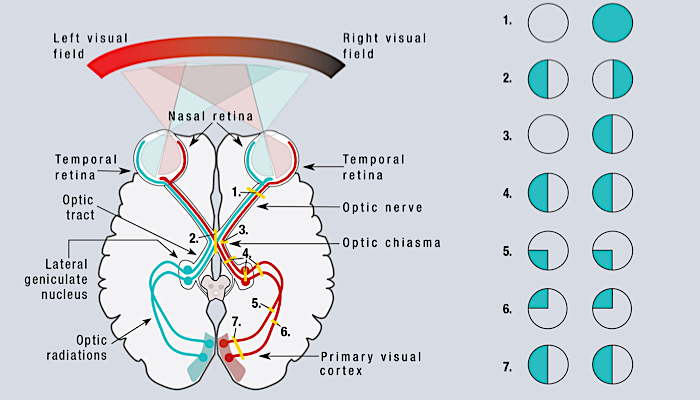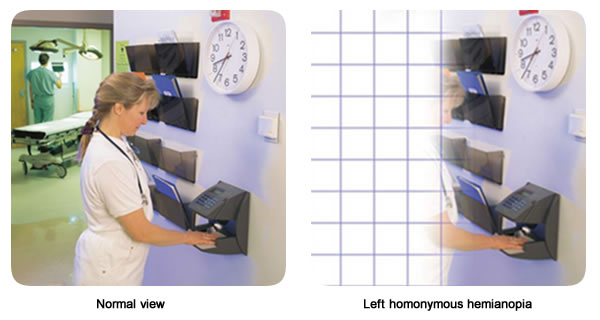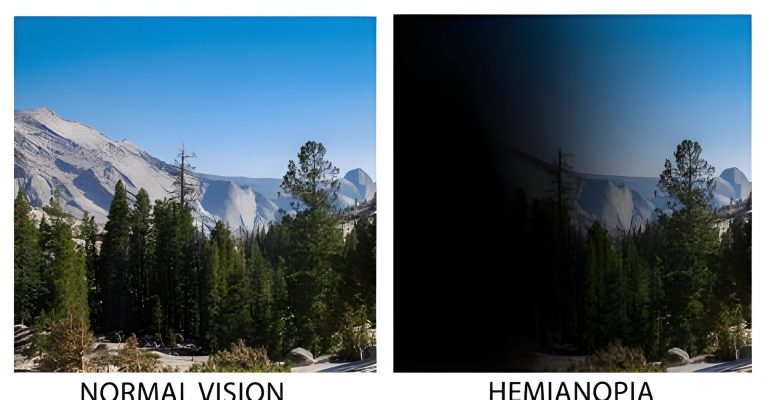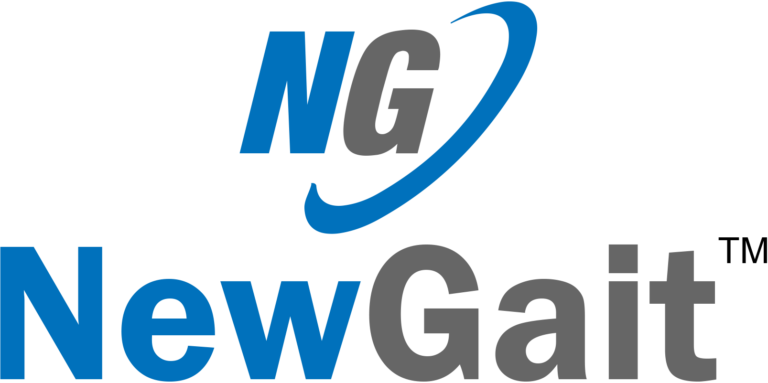Some may believe that they have a left visual field impairment. They could be suffering from an area called left neglect. Though it may look somewhat similar, it has quite different causes.
Understanding the differences between a left visual field cut and left neglect becomes imperative. This is synonymous with knowing apples from oranges. With each knowledge, one easily identifies the right way to handle each condition. Therefore, a wealth of experience is needed to differentiate between the two and understand what approach would best fit each.
Left Visual Field Cuts
The name “visual field cuts” literally implies that part of your vision has been “clipped” away. This can result in total blindness or diminished vision to half what you normally see. Another name you’ll hear for this is hemianopsia.
It’s usually more pronounced on the left, so we call it a left visual field cut. This doesn’t mean anything is wrong with your left eye physically, per se. The problem is within the brain; it just has some difficulty interpreting what your left eye sees.
Here’s a bit more context—each half of our brain works on interpreting the visual data from the opposite side of our body. So, when the right side of the brain suffers a hit, it falters in understanding what your left eye sees. There you are, experiencing what we call a left visual field cut.
Difference Between Neglect and Field Cuts
Hemineglect is an attention disorder. Imagine not knowing what goes on on one side of you, whether people, things, or activities—that is hemineglect. It frequently occurs on the left side, so doctors sometimes refer to it as ‘left neglect.’ Other times, it is referred to as one-sided neglect and hemispatial inattention.
Now, something to clarify: left neglect is not about having problems with your vision, like left field cuts. It’s more of an attention problem. More often than not, a stroke involving just one section of the brain—the right parietal lobe—will do the trick.
Imagine you are coming up to someone who has left neglect. They may not even know you are there. Don’t take it personally! It can sometimes give the impression that the person is deliberately overlooking you, but it isn’t so. They just have difficulty paying attention to anything on the left side. Thus, they don’t mean to be rude or standoffish; they just have an attention problem.
Conversely, hemianopsia is a condition of visual failure due to damage to the optic nerve or severe trauma to the brain, in which one-half of the field of vision is lost. It differs from hemineglect in that it is mainly a physical problem with seeing rather than an attentional disorder.
Left Visual Field Impairment and Neglect Symptoms
The symptoms of left visual field cuts and neglect are similar; hence, confusion can be expected between them. Some common symptoms include bumping into things on the left side, difficulty reading or writing from the left side, and difficulty with spatial awareness.
Some more specific symptoms allow distinguishing between the two. The symptoms of hemineglect include a lack of awareness of body parts on the affected side of the body. Forgetting to use the left arm in hemianopsia. There is partial blindness affecting either the right or left halves of the retinae of both eyes.
Causes of Left Visual Field Cuts and Neglect

As written above, the left visual field cuts are usually due to damage on the right side of the brain, while the left neglect is caused by damage in the right parietal lobe. The most frequent cause for both conditions is:
Stroke
Stroke is one of the major causes of hemienglect and hemianopsia. Blockage or bleeding in the right-hand side of the brain may affect vision or attention on the left side. Note that strokes may affect other parts of the brain, which causes different types of blindness.
In case you get a stroke, what happens in your body will determine your fate. If the damage is restricted to the right brain, then it’s very likely a left visual field cut or left neglect.
Traumatic Brain Injury
Both visual field cuts of the left and neglect can also be a result of accidents because head trauma could cause damage in specific areas, particularly on the right side of the brain and the right parietal lobe.
Even the mildest head injuries can exhibit visual impairment or problems related to attention disorders, so one must seek medical attention if there are persistent symptoms after suffering from a head injury.
Other Causes of Left Visual Field Impairment
Conditions like brain tumors, infections, or neurological disorders also occasionally cause left-sided visual field cuts and neglect. Suppose there is a sudden onset of these symptoms, yet no one knows the causes. In that case, seeking medical advice to get a proper diagnosis and treatment is essential.
Diagnose The Left Visual Field Impairment and Neglect
Diagnosis of these left visual field cuts and neglect involves a comprehensive investigation. The patient provides the case history and symptoms, together with a set of various tests. This includes perimetry or confrontation visual field tests—the patients are asked to detect an object or pattern within their full-field or hemifield visions—and neuropsychological tests to detect probable attention deficiencies.
There is also a more specific test for hemineglect, the Apple test. The patient was asked to sort out and identify the types of fruits given in a bowl, some of which were arranged on the left or right side of a plate. A person with left-sided neglect will have more difficulty identifying or sorting the fruits set on their left side.
Meanwhile, in hemianopsia, specialized imaging tests could resort to an MRI or CT scan to reveal any damage to the optic nerve or brain since it is a physical problem with vision rather than an attention disorder.

Left Visual Field Cuts and Neglect: Treatment Options
Different treatments are required for visual field cuts and hemineglect. A proper diagnosis by the doctor is essential to begin appropriate treatment on the right note.
Let’s consider options for left visual field cuts and left neglect treatment. Everyone’s path to recovery is very different, and these ways are somewhere along that journey.
Left Neglect Rehabilitation
Left-neglect treatment involves aiding the patient in focusing and becoming more aware of his or her left side. Visual scanning training measures involve….the patient must turn the head towards the left-hand side, seeing the environment. This helps train the mind to be referred to one’s left-side environment and might decrease the results of left neglect.
Another treatment is known as limb activation. This treatment involves moving the left arm and leg within the neglected environment. Its effectiveness is derived from factors that make the patient aware of his left side. It helps fight hemineglect because visual attention and the function of motor skills are closely linked.
Most of these rehabilitation techniques utilize the concept of neuroplasticity. This enables the brain to further reorganize itself and develop its functions.
Left Visual Field Cuts Rehab
Suppose someone suffers cuts in their left visual field. In that case, experts intervene to reconnect the brain to start processing visual information again.
The first is oculomotor exercises, which help patients move their eyes toward the left field. The goal is to get the brain in rhythm again, scan the left-side surroundings, and start processing information from the area once more.
Next, come the field expanders and prisms. These do not really cure the root problem but provide quite a neat Band-Aid solution. They can help shift images from the blind field and are, therefore, of great use to patients in visualizing during daily activities.
A good example is restorative visual therapy, which includes exercises like saccadic eye movements that induce stimulation at the edge of the lost visual field. NovaVision is a fine example of this.
Of course, the revival will depend on how serious the condition is. Sometimes, hemianopia patients improve spontaneously without any effort. While it does not repair the cuts in their visual fields totally, it can, on other occasions, make a partial improvement.
Living with Left Visual Field Cuts and Neglect
It’s important to note that living with left visual field cuts and neglect can be challenging. Simple tasks such as reading, driving, or even walking can become difficult due to impaired vision and attention on the left side. As a result, individuals may experience frustration, anxiety, and depression.
However, there are ways to adapt and cope with these conditions. For example, assistive devices such as magnifiers or prism glasses can help improve vision in the affected areas. Environmental modifications like arranging furniture to avoid bumping into neglected objects can also make daily activities easier.


